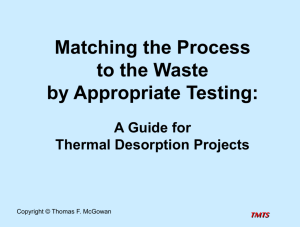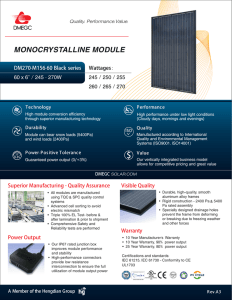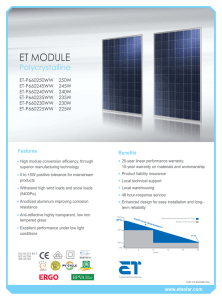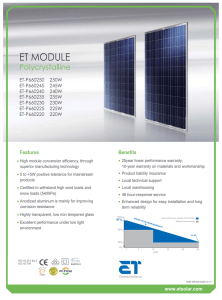Tom McGowan - VOC and Odor Control Options
advertisement
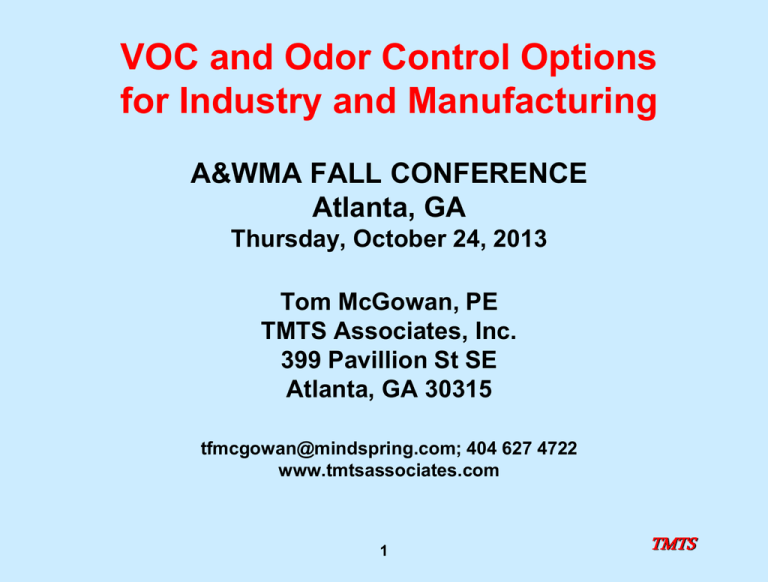
VOC and Odor Control Options for Industry and Manufacturing A&WMA FALL CONFERENCE Atlanta, GA Thursday, October 24, 2013 Tom McGowan, PE TMTS Associates, Inc. 399 Pavillion St SE Atlanta, GA 30315 tfmcgowan@mindspring.com; 404 627 4722 www.tmtsassociates.com 1 TMTS What’s the Problem? Generation of ground level ozone via reaction with NOx • Lots of names: VOCs, HAPs, NCG's • Multiple regulations: HAPS, SOCMI-HON, PHARMA • Examples: – Gasoline and diesel fumes from tanker truck loading – Formaldehyde from processes and manufacturing – Solvent emissions from coating – High concentration fumes from chemical processes – NCG's (noncondensable gases) from processes – Refinery tanks and petroleum terminals – Sludge remediation projects and tank cleanouts 2 TMTS 2 VOC Abatement Options LOWER PRODUCTION PROCESS CHANGES REFORMULATE RELOCATE VOC EMISSIONS CARBON ADSORPTION COLLECT VOCS CONDENSATION DUCTWORK/ COLLECTION SYSTEM (SEE ACGIH, “INDUSTRIAL VENTILATION” HANDBOOK) OXIDIZE VOCS THERMAL AND THERMAL CATALYTIC OTHER OPTIONS -- BIO FILTRATION, BOILERS 3 TMTS 3 Basic Design Data • Process flowrate and temperature of VOC stream • Concentration of the VOCs • Composition of carrier – Nitrogen, Oxygen, Air, Steam/Water Vapor • Chemical properties (especially Cl, S) • Particulates, ash, soot, silicon dust • Nature of process (continuous, cyclical, variable flow and VOC composition) • Potential application for use of waste heat • State and federal regulations 4 TMTS 4 Optimizing abatement system choice The wrong choice means higher fuel use and emissions! Chemical Eng. magazine, February 2007, used with permission 5 TMTS Control Options Collection with Activated Carbon • Must prevent ignition due to heat of absorption! – Need sprinklers – Need CO/CO2 detectors/thermocouples to detect ignition – Must be below dewpoint entering carbon • Zeolites used -- similar to carbon • Membranes also used for polyolefins and other VOCs • Desorb/condense for recovery, or concentrate for oxidizer, or ship offsite for disposal/regeneration 6 TMTS 6 Refrigerated Condensers • Used for high concentrations (e.g., 500,000 ppm/50% by volume organics) and low flows • Allows recycle of organics from single source processes, e.g., gasoline transfer operations • Condensation from multisource processes can yield a mixture of organics which is not useable and has low market value Refrigerated condenser Used with permission, Edwards Vapor Recovery 7 TMTS 7 Limits of Flammability vs. Inert Percent in Air % Air = 100% - % Combustible Vapor - % Inert UEL T1 COMBUSTIBLE VAPOR, volume percent T2 > T1 Non-flammable mixtures Flammable Mixtures LEL INERT, volume percent 8 TMTS 8 LEL/UEL of Pure Gases and Vapors in Air Rule-of-Thumb -- 25ºF Rise per 1% LEL Gas or Vapor Lower Limit % Vol Upper Limit % Vol Gas or Vapor Acetaldehyde 4.0 57 Butyl cellosolve Acetone 2.5 12.8 Carbon disulfide Acetylene 2.5 80 Carbon monoxide Allyl alcohol 2.5 -- 15.5 Amyl acetate Lower Limit % Vol Upper Limit % Vol -- -- 1.2 50 12.5 74.2 Chlorobenzene 1.3 7.1 26.6 Cottonseed oil -- -- 1.0 7.5 Cresol, M- or p- 1.1 Amylene 1.6 7.7 Crotonaldehyde 2.1 15.5 Benzene (benzol) 1.3 6.8 Cyclohexane 1.3 8.4 Benzlyl chloride 1.1 -- Cyclohexanone 1.1 Butene 1.8 8.4 Cyclopropane 2.4 10.5 Butyl acetate 1.4 15 Cymene 0.7 -- Butyl aclohol 1.7 -- Dichlorobenzene 2.2 9.2 Ammonia 9 TMTS 9 Direct Fired Thermal Oxidizers • • • • • Refractory lined chamber + burner Fouling not an issue with correct design/layout For odor control, 1200ºF is minimum General guidelines: – 90%destruction of VOCs, operation @1450-1500ºF minimum, dependent upon VOC – 98% DE, 1600ºF @ 0.75 sec. residence time – Halogenated VOCs, 1800ºF @ minimum 1 sec. with high intensity burner/good mixing – With low intensity flame burner, 2 sec. minimum res. time For recuperative type, add HX to preheat VOC stream: – Plate type < 1400oF; shell & tube type > 1400oF 10 TMTS10 Direct Thermal Oxidizer Upfired – with no acid gas or dust Rich/Lean “DeNOxidizer for fuel bound N2 Used with permission Callidus 11 TMTS11 Steps Required for Successful Oxidation of Dilute Fumes Supplemental Fuel Outside Air (If Used) Dilute Fume Fuel Combustion Mixing of Fume and Hot Combustion Gases Retention of Fumes at High Temperature for Sufficient Time Clean Effluent Fume to Supply Oxygen for Fuel Combustion (Outside Air Needed If Fume Fouls Burner or is <16% Oxygen) 12 TMTS12 Fluid Dynamics – Mixing of waste Gas and Flame Baffles frequently used, e.g., “disk and donut,” to provide macro mixing 13 TMTS13 OXIDIZER WITH HEAT RECUPERATOR WASTE GAS 10000 SCFM 200° F Stack 850° F 1600° F Oxidizer Heat Recuperation NATURAL GAS 1500 SCFH PLUS 8 MM Btu/hr VOC 14 TMTS14 Shell and Tube Heatexchangers – Tube Side Bellows for Expansion 15 TMTS15 Shell and Tube Heatexchangers – Shell Side 16 TMTS16 Plate Type Heat Exchanger 17 TMTS Catalytic Oxidizers • For low concentrations, typically, 5-15% LEL • Provides good oxidation at reduced temp • Frequently use HX to preheat fume stream, typically to 600ºF • Usual max temp 1200ºF • Fouling/poisoning an issue (platinum deactivated by chlorinated compounds) with lead, arsenic and phosphorous • Particulate can blind catalyst pores • Catalysts for chlorinated VOCs (Chromia alumina, cobalt oxide, copper /MgO) • Periodic catalyst replacement required 18 TMTS HX can be added to make it catalyticrecuperative, preheating the fume 19 TMTS Catalytic Oxidizer 20 TMTS RTO (Regenerative Thermal Oxidizer) • • • • • • • Used for 3-5% LEL VOCs; W/hot gas bypass, up to 20-25% LEL Cyclic process - provides very high (95%) energy recovery, 5% of that required for direct flame oxidizer High capital cost, very low operating cost Uses a “heat sink” of heat absorbing ceramic materials Two chamber units have trouble achieving high (e.g., >98%) DE Best to use 3 chamber or puff chamber types to reduce momentary low DE during valve change over for odor control and higher DE Circular/rotary valve type has internal purge, similar to 3 chamber/puff chamber type 21 TMTS RTO (Regenerative Thermal Oxidizer) Critical Design Issues – Cold face build up (if organic, use auto bakeout cycle) – Fog/mist entering beds, best to use coalescing mist eliminator upstream, and two or three chamber with bakeout – Condensate in the underbed plenums, increase cycle time/raise exhaust/underbed plenum to keep plenums dry – Dust plugging the beds (need filter upstream) – Corrosion: Wall temp is cool and SO2/HCl may reach dewpoint; use mastic coat on walls or SS alloy 22 TMTS RTO Cutaway View Used with permission Durr Environmental 23 TMTS Three Bed RTO With Bed Purge for Off-Cycle Bed Used with permission Durr Environmental 24 TMTS VOC Controls -- Flares • For waste gases above LEL • Steam injection or air assist for “smokeless” flare • Elevated flare minimizes radiation to ground and surrounding structures • Ground flare conceals flame in refractory lined chamber • For process upsets, rapid pressure rise or rapid production of VOCs or more constant flow/small vents that are not recoverable for useful heat (e.g., LFG) • Per 40 CFR 60 AP 42 TCEQ, the following minimum fuel values are required: – Steam-assisted - 300 Btu/scf – Air-assisted - 300 Btu/scf – Non-assisted - 200 Btu/scf – Can boost with natural gas to achieve minimums 25 TMTS Elevated Flare Tip 26 TMTS Elevated Flare 27 TMTS Air Assisted Enclosed Ground Flare Two stage flare for wide range of flows. Quench air keeps temp at TC 5001400F Used with permission of John Zink Company 28 TMTS Shielded Elevated Flare Used with permission of John Zink Company 29 TMTS VOC System Safety and Explosion Issues 30 TMTS NFPA Codes Re Ignition in VOC Systems • Most oxidizers operate < 25% LEL, which is NFPA 86 Limit for combustion equipment with standard controls • NFPA 86 allows up to 50% LEL with extra controls: “where a continuous solvent indicator and controller is provided” … plus “alarm and shut down” to “not exceed 50 percent of the LEL” • Engineered systems operate above 50% LEL, e.g., flares, with proper protection, such as seal pots, and proper design and operation • Controls must be able to monitor all the combustibles that may enter the oxidizer; problems may occur, e.g., with vapor analyzers that don’t see fuel value of liquid droplets 31 TMTS Flame Arrestors Used for Some Applications Used with permission of Protectoseal® 32 TMTS Georgia Case Study – Blue Haze Abatement • Application: Pine veneer drying • VOC terpenes, blue haze = submicron droplets • Flow and VOC data suspect: Tuned burners, got higher true value at 30,000 acfm and VOCs • Chose 2 chamber RTO with auto-programmed bakeout cycle to address cold face buildup • Preliminary design of ducts, all sloped to drip tee • Wrote spec, got quotes, helped client contract • Supplied permit and compliance input 33 TMTS Questions? 34 TMTS
